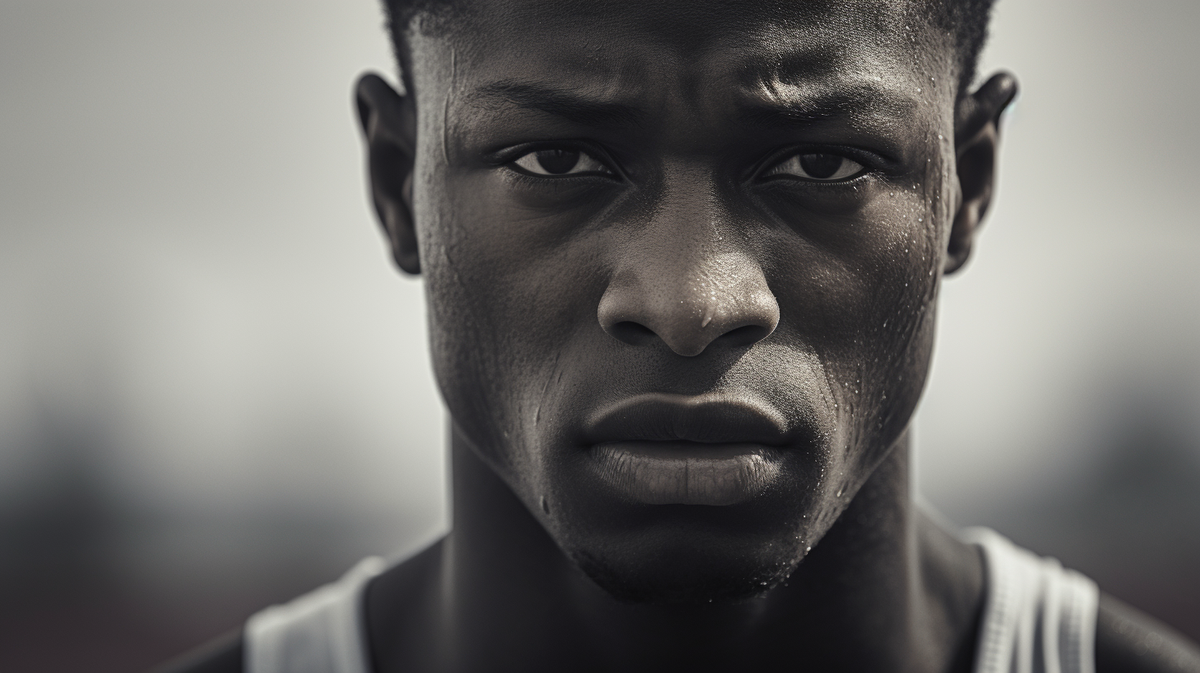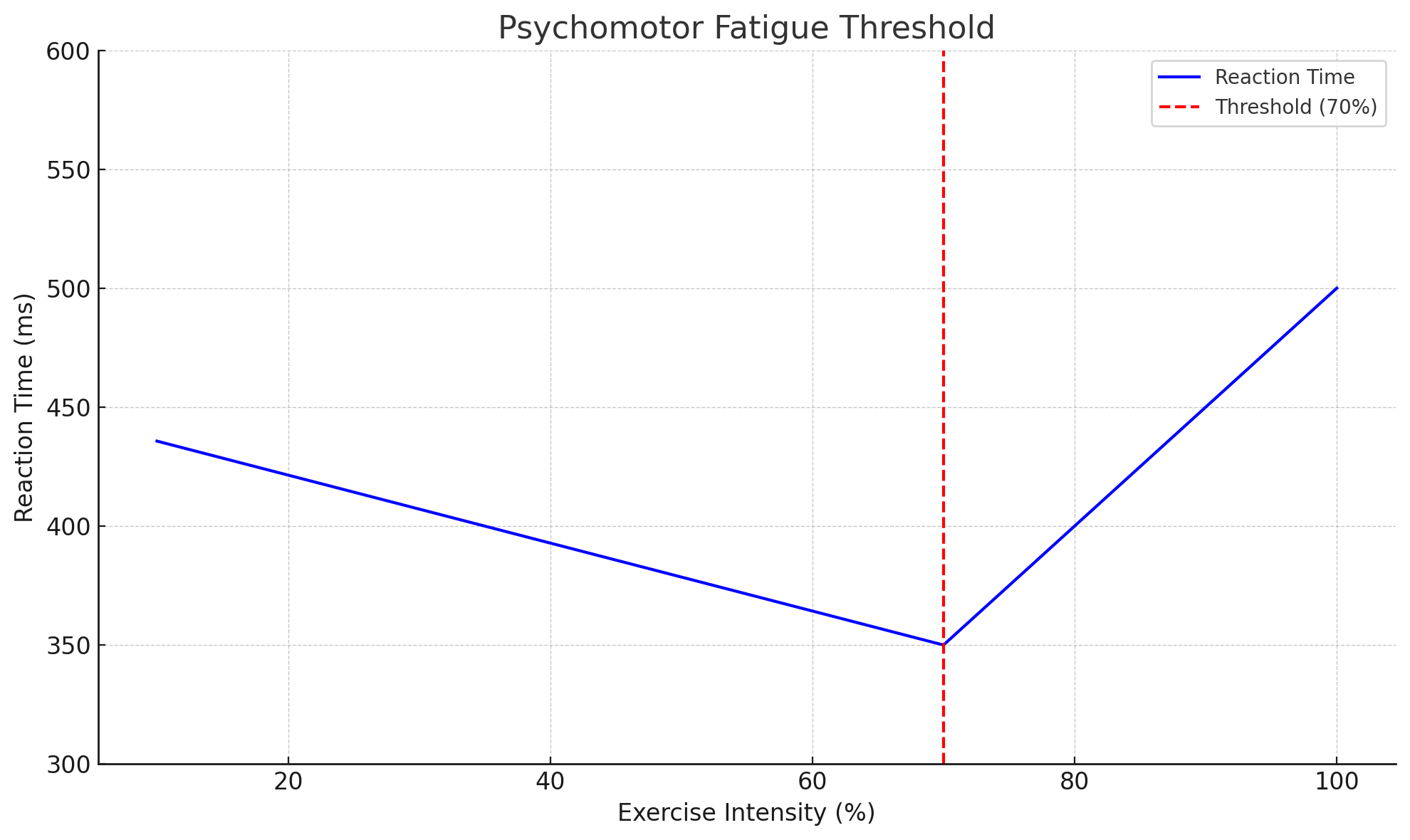PFTT in Action: How to Seamlessly Include It in Your Athlete's Training Plan
The Psychomotor Fatigue Threshold Test (PFTT) is designed to determine the precise moment when an athlete's cognitive responses, especially reaction times, are at their peak during escalating exercise intensities.

The Psychomotor Fatigue Threshold Test (PFTT) is designed to determine the precise moment when an athlete's cognitive responses, especially reaction times, are at their peak during escalating exercise intensities. As physical exertion increases, cognitive performance initially improves, reaching an optimal level. However, past this peak, cognitive signs of fatigue begin to appear, even if the athlete's physical performance endures. This critical point is what the PFTT aims to identify. In essence, it pinpoints the "sweet spot" where an athlete's decision-making is the fastest and most accurate, unaffected by fatigue or cognitive overload.
The graphic below illustrates how cognitive responses enhance with increased exercise intensity up to a point, after which cognitive performance starts to decline.

By recognizing this threshold, coaches can customize training sessions with greater accuracy. Training can be specifically designed to not only challenge but also to expand this threshold, thereby pushing the limits of both physical and cognitive capabilities.
Incorporating the PFTT task during a training session is optimal when interspersed between physical exercises or strategically placed at the beginning, midpoint, and end of the session. A decline in an athlete's reaction time is indicative of surpassing the fatigue threshold. However, this threshold can be extended with consistent and progressive training, leading to a decrease in the rate of decline in reaction times as the athlete's overall capacity improves.
Example Training Session with PFTT Integration
Here's what a session might look like when integrating cognitive and physical training components:
- Pre-Session PFTT: Establish baseline cognitive performance metrics.
- Physical Exercise: Engage in the first set of exercises.
- MSIT 3m: Perform the Multi-Source Interference Task for 3 minutes to test cognitive interference and control.
- Physical Exercise: Continue with the next set of exercises.
- Posner 3m 90%: Conduct the Posner task for 3 minutes at 90% intensity to assess attention.
- Physical Exercise: Follow up with additional physical exercise.
- Sustained Attention 3m: Engage in a task for 3 minutes to measure sustained attention.
- Physical Exercise: Proceed with more physical exercise.
- Mid-Session PFTT: Re-evaluate cognitive performance after physical exertion.
- Physical Exercise: Resume physical exercise.
- CMSIT 3m: Carry out the Coloured Multi-Source Interference Task for 3 minutes.
- Physical Exercise: Engage in further physical activity.
- Spatial Stroop 3m 90%: Perform the Spatial Stroop Task for 3 minutes at 90% intensity.
- Physical Exercise: Continue with physical exercises.
- AX-CPT 3m: Execute the AX Continuous Performance Test for 3 minutes.
- Physical Exercise: Complete the final set of exercises.
- End-Session PFTT: Assess the post-session cognitive performance.
If the training session is adequately loaded, you might observe a deterioration in PFTT reaction times in the post-session assessment. For instance, reaction times might progress from 340 ms (pre-session) to 290 ms (mid-session), and then to 440 ms (post-session), suggesting the threshold was crossed, evidenced by slower reaction times on the final PFTT. As the athlete adjusts to the training load, you may observe minor fluctuations in PFTT task data, such as 340 ms, 360 ms, and 350 ms, indicating they are adapting to the training intensity.
To extend an athlete's cognitive and physical capabilities, incorporating additional Psychomotor Fatigue Threshold Tests (PFTTs) can be highly informative. Once an athlete has surpassed their initial fatigue threshold, subsequent PFTT tests can reveal two distinct patterns in their reaction times:
Pattern One: Fluctuating Reaction Time
This pattern exhibits variability in reaction times, which may not follow a clear trend of improvement or deterioration. For instance:
- Pre-Session: 340 ms
- Mid-Session: 290 ms
- Post-Session: 440 ms
- Additional Tests:
- 460 ms
- 430 ms
- 475 ms
- 450 ms
- 445 ms
These fluctuations suggest that the athlete's cognitive fatigue is not consistently worsening, which could indicate resilience in cognitive function despite fatigue.
Pattern Two: Deteriorating Reaction Time
This pattern shows a clear trend of increasing reaction times, indicating progressive cognitive fatigue:
- Pre-Session: 340 ms
- Mid-Session: 290 ms
- Post-Session: 440 ms
- Additional Tests:
- 460 ms
- 490 ms
- 510 ms
- 525 ms
- 530 ms
A consistent increase in reaction times across successive tests suggests that the athlete is experiencing increasing cognitive fatigue, potentially impairing their cognitive performance.
Adaptation to Cognitive and Physical Training
As athletes become more accustomed to the demands of cognitive and physical training, their reaction times may begin to stabilize. The differences between tests may diminish, or reaction times may fluctuate within a narrow range, typically a few percentage points. This stabilization is an indicator of adaptation, reflecting the athlete's improved ability to handle cognitive demands even at higher levels of physical exertion.
To conclude, The Psychomotor Fatigue Threshold Test (PFTT) is a powerful test. It precisely identifies when an individual's brain response, particularly reaction times, is at its sharpest during increasing exercise intensities. As physical exertion rises, so does cognitive performance—up to a certain peak. Beyond this point, even if physical endurance persists, cognitive fatigue starts to emerge. The PFTT zeroes in on the optimal moment for decision-making, just before fatigue creeps in. With this threshold in mind, training can be more effectively customized. Trainers are able to design workouts that thoughtfully challenge both the brain and body.
🏋️♂️🧠 TL;DR: PFTT finds the "sweet spot" in workouts where the brain's sharpness peaks before fatigue hits.
📈 As workouts intensify, thinking gets sharper... to a point.
🔍 Coaches use this to tailor training perfectly.
Training Steps:
1️⃣ PFTT before training 📏
2️⃣ Mix physical drills with cognitive tasks 🔄
3️⃣ Mid & End: Re-test PFTT 🧠
Outcome: Athletes can push their mental and physical limits further 🚀💪
Research
Changes of Reaction Time and Blood Lactate Concentration of Elite Volleyball Players During a Game
Psychomotor performance during prolonged exercise above and below the blood lactate threshold
Mental Fatigue and Sport-Specific Psychomotor Performance: A Systematic Review
🌐 Connect With Us
🌍 Soma Technologies: Engineered to enhance human performance.
📸 Instagram: Dive into our world through exclusive photos and stories.
👥 Facebook: Join our community for the latest updates and discussions.
📈 LinkedIn: Connect with us professionally and stay informed about industry news.
🎥 YouTube: Watch our latest videos, tutorials.
🐦 X: Follow us for instant updates, news, and engaging tweets.
